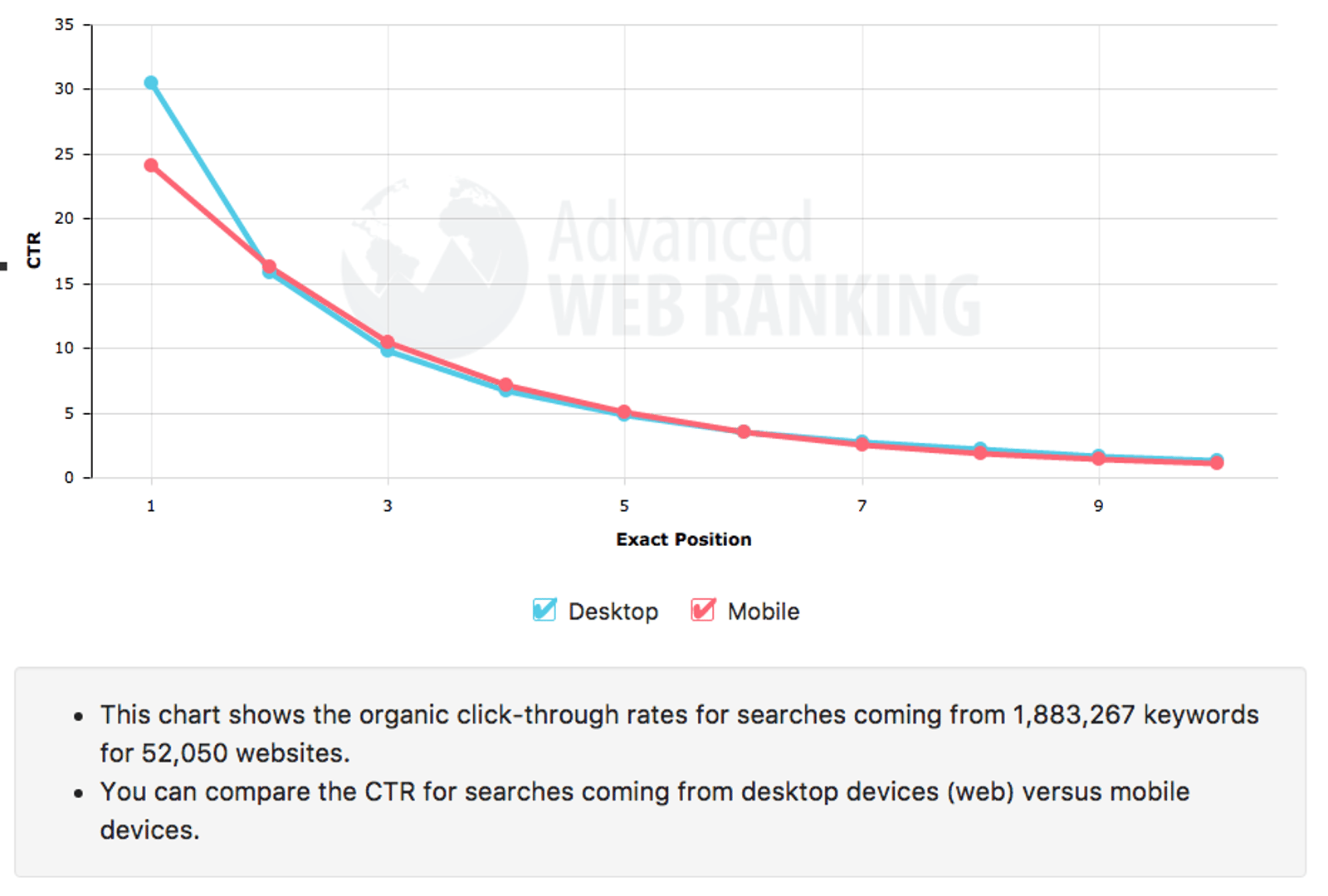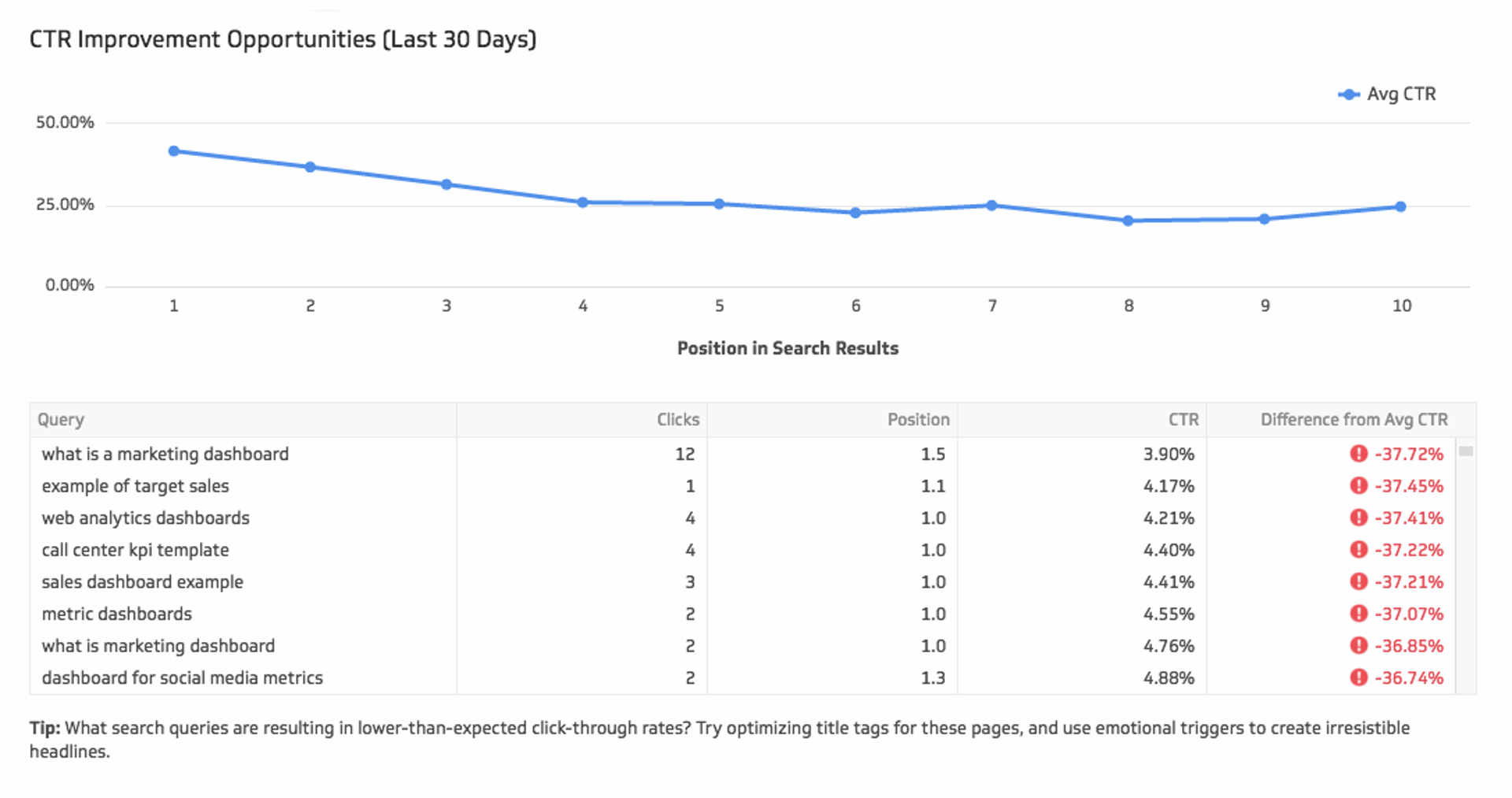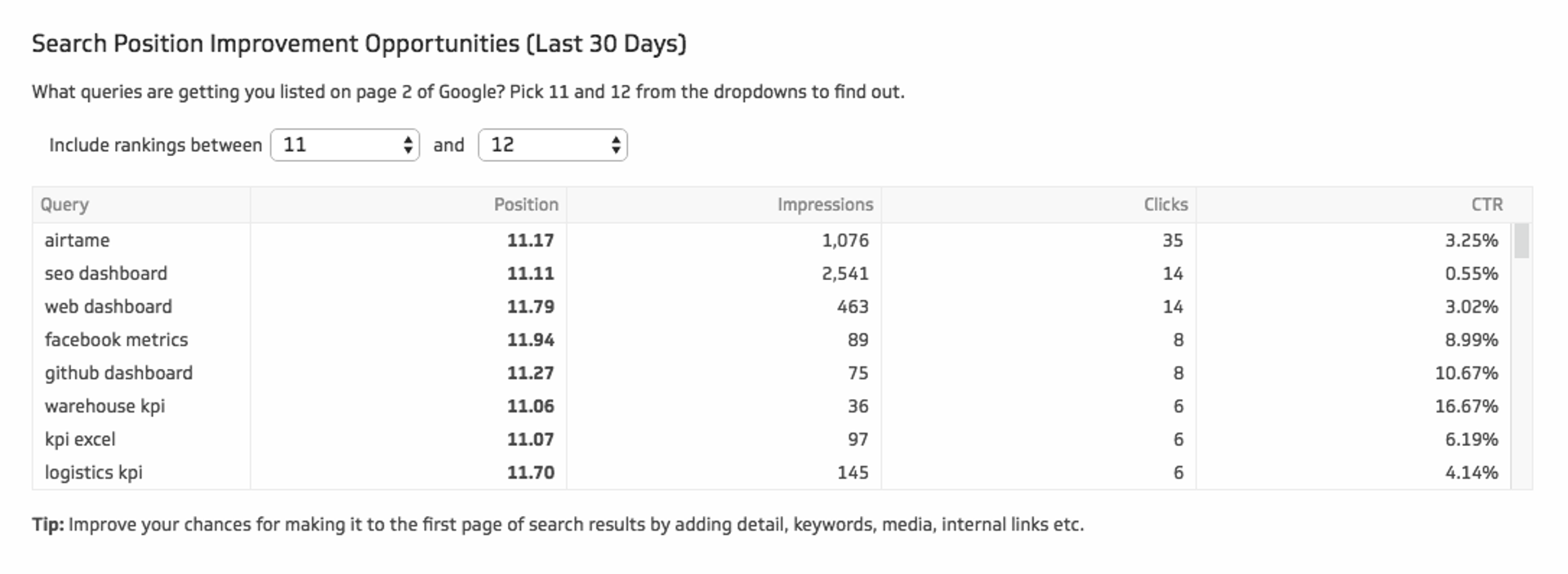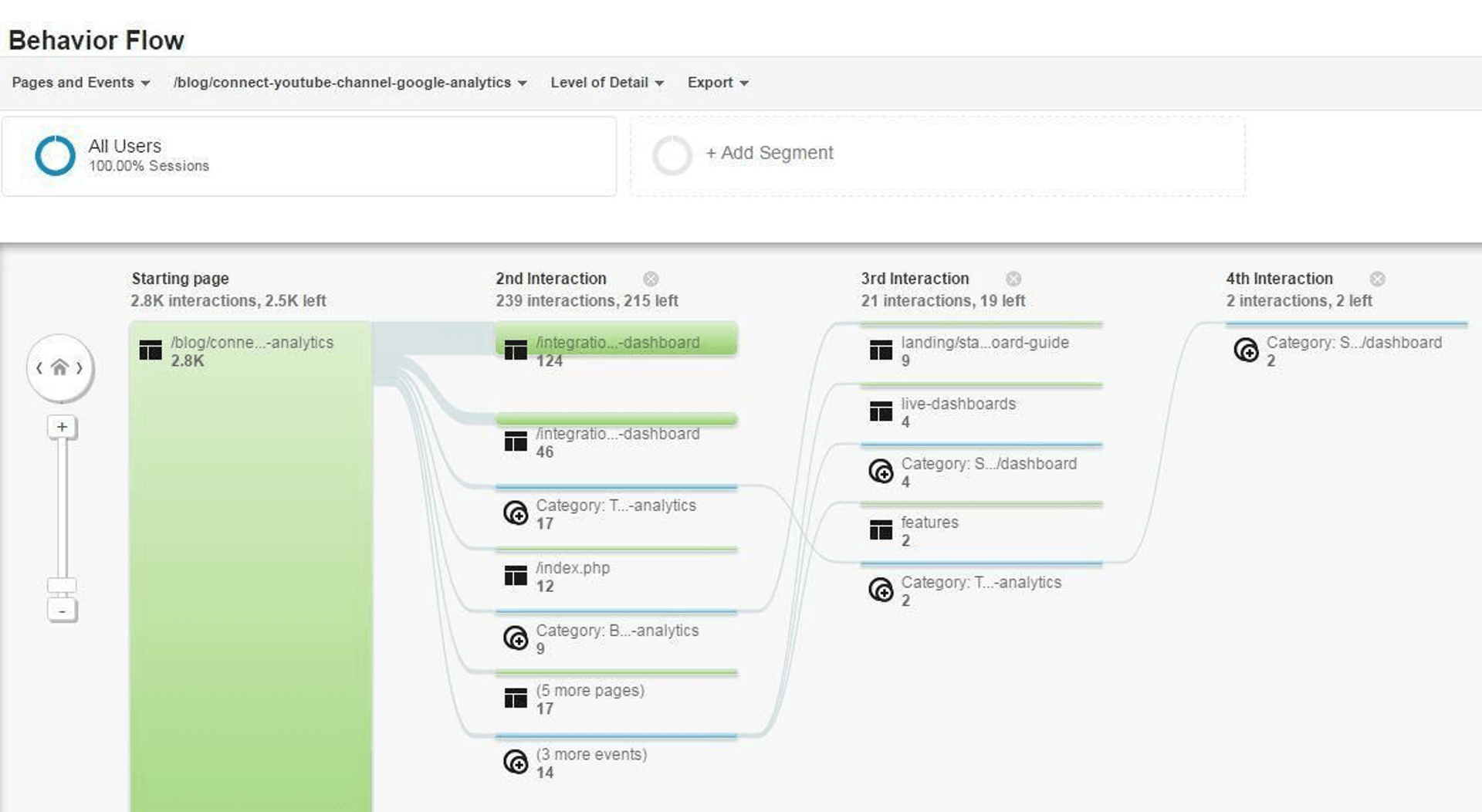4 Content Marketing Metrics You Should Be Watching Carefully - Here’s How

Live content marketing dashboards make metrics easier to access and monitor
If you’re a content marketer, you likely already measure marketing metrics like Impressions and Goal Conversions.
The problem with these metrics is that, even where they’re actionable, there’s often uncertainty about what actions to take, in what order, and with how much effort.
If you’ve been publishing for awhile, you’ve probably asked yourself:
- What can I do to optimize all this content?
- Where should I start?
- What’s the ROI on this effort?
Over the past few weeks we’ve been introduced to some great new reports in Google Analytics (GA) and Google Search Console, which have helped us answer these questions.
They’ve come to us from content marketing experts through research we’re conducting to build best in class content marketing dashboards.
Turns out there’s a wealth of data available in GA that can not only help you identify underperforming content, but prioritize what content to improve first, and forecast the return on your time investment.
You just have to know where to look for it.
But then there’s a second challenge.
Even when you know where the data is, it's not always easy to get to. As Andy Crestodina explains in this awesome article, often times you have to dig-in to GA, and in some cases export to Excel, to view results against targets, benchmarks or historical trends.
That’s not ideal if you’re trying to optimize content on the fly.
So more questions arise:
- How can I get to the GA data quickly and turn it into readily available information?
- How can I operationalize this information so I can make informed and timely decisions about what content to optimize?
Our response to this challenge has been to build out dynamic data visualizations and dashboards with Klipfolio, referencing data points in Google Analytics and Google Search Console.
This saves us from having to dive into two or three layers of these tools and fiddle with dimensions and parameters every time we want to know how we’re doing.
The result is that we always have a view to how our content is performing, and where our biggest content improvement opportunities lie.
Below I’ll tell you about some of the most valuable content marketing metrics and insights we’ve been tracking, and how.
Click Through Rate (CTR) Improvement Opportunities
Most digital marketers track how their content’s performing based on metrics like organic search ranking (on targeted keywords) and click-through-rate (CTR).
If content is ranking highly (say, top three search results for a particular query), satisfaction sets in and optimization efforts are paused until content drops significantly in rank.
But what if, despite ranking highly, your content isn’t pulling in high traffic?
Would you be disturbed to know that your number one ranked blog for a given query is only capturing 10% of all clicks for that query?
We were.
According to a CTR study by Advanced Web Ranking, on average, content that is ranked first on an organic search query draws about 30% of all clicks for that query. Content ranked second tends to generate a CTR of about 15%, and third ranked content usually achieves a CTR of 10%.

This research, which is also supported by a study done by the online ad network Citika, confirms what you probably assumed intuitively: the higher your organic content ranks, the higher your CTR should be.
But the research also gives you some specific content marketing benchmarks to strive for:
| Organic Search Rank | Benchmark CTR |
| 1 | 30% |
| 2 | 15% |
| 3 | 10% |
| 4 | 7% |
| 5 | 5% |
So now you know what to look for: content that’s ranking high in search results, but low in click through rate.
Because as much as that’s a problem, it’s an opportunity.
Consider, for example, a situation where you have content ranking second for query X, and 100,000 people are typing query X into their search engine each month. On average you should be receiving 15,000 clicks (100,000*15%). If instead you’re receiving 2,500 clicks, you’re only capturing 2.5% of available traffic.
In this example, raising the CTR on your content from 2.5% to 15% could drive up to 12,500 more people to your content each month.
So how do you monitor metrics like average SERP position and CTR, to ensure you’re attracting clicks commensurate with your ranking?
Well you can dive into Google Analytics: Acquisition > Search Console > Queries. But while this isn’t difficult, it can be a pain to constantly jump in and out of the tool, and it will take you three or more steps to set up the report. It can also be difficult to see where your big opportunities lie, because there is nothing in GA that will show you where there is a discrepancy between SERP position and expected or target CTR.
We automated the retrieval of this data from GA and created this data visualization in Klipfolio to give us a quick view to our performance:

View on a live dashboard
This data visualization gives us quick visibility into how our top ranked content is performing or underperforming based on CTR.
It pulls in the following data from Google Analytics dynamically (close to real-time):
- Column 1: search engine queries for which we have high ranking content
- Column 2: the total number of clicks our content has received (over the past 30 days)
- Column 3: the average position of our content in SERPs (over the past 30 days)
- Column 4: the CTR on our content based on total impressions (over the past 30 days)
Column 5 is a custom column we created in Klipfolio. It highlights where our CTR is low for where our content’s ranking in SERPs. We’re using a formula to display the difference between the CTR displayed in column 4 and the CTR the content should be receiving, based on the position listed in column 3. Indicators (red font and exclamation points) highlight where we’re missing some big opportunities.
Looking for tips to improve your CTR? Check out the bottom of #2 two in this post.
Search Rank Improvement Opportunities
The difference in ranking on the first page of organic search results, and any page thereafter, is huge. Research suggests that only 8.5% of search traffic make it past the first page of results.
That said, the effort it can take to push a piece of content up many positions can be high, especially in highly competitive keyword categories.
To get the most out of your content optimization efforts, look to improve content that ranks at the top of page two of search results; getting those listings bumped to the first page of organic search rankings will provide the greatest ROI.
So, how do you monitor content ranking at the top of page two of search results, so you can prioritize improving them?
Again, you can view the average search rank position of your web content in Google Analytics, under Acquisition > Search Console > Queries.
Next, filter the results to display only the listings with an average position of 11 or 12 (Advanced>Add a Metric>Avg Position); you’ll find that this is the content that currently sits in the top two positions of page two of the search results.
We automated the retrieval of this data and created this data visualization in Klipfolio to give us a quick view to our performance:

View this data visualization on a live dashboard
This data visualization helps us prioritize what content to improve, to obtain the highest ROI.
It pulls in the following data from Google Analytics dynamically (close to real-time):
- Column 1: search engine queries for which we have content ranking in positions 11 and 12
- Column 2: the average position of our content in SERPs (last 30 days)
- Column 3: the total number of impressions our content has been receiving in these positions (last 30 days)
- Column 4: the total number of clicks our content has received in these positions (last 30 days)
- Column 5: the click-through rate, calculated as column 4 divided by column 3
Top Posts by Page Views and Conversion Rate
It’s often the case that your top traffic generating content is not your top converting content, and vice versa.
In these situations, a smart content marketing strategy is to pair posts that bring in a lot of traffic with related posts that rate well for conversion.
So, how do you identify high traffic and high converting content, so you can pair them?
You can get identify your top content by pageviews pretty easily in GA: Behaviour > Behaviour Flow > Site Content > All Pages
If you want to filter to see pageviews for a specific type of content, like blog posts, you can write that (exp. “/blog”) in the search bar next to advanced.
Identifying your top content by conversions is a bit more tricky. You can start by going to Conversions>Goals>Reverse Goal Path. Then click the “goal option” drop down to select the goal you’d like to track - blog subscriptions, trial starts, ebook downloads etc. (whatever you have set up).
Now, to begin to think through a logical linking strategy, you’ll want to see top content by pageviews and top content by conversion side by side.
How do you do that?
You can export each of the two reports to Excel and align the data. Then you can repeat this entire cycle every week or so, to account for changes and to make sure you’re doing it right.
Or you can build a data visualization like this in Klipfolio:

View this data visualization on a live dashboard
This data visualization enables us to quickly toggle between top performing content by page views and conversions, so we can think through a logical linking strategy.
It pulls in the following data from Google Analytics dynamically (close to real-time):
Bar chart
Filter: number of pageviews
Y Axis: top blogs posts ordered by the most pageviews
X Axis: total number of pageviews for each blog post
Table
Column 1: top blog posts
Column 2: total pageviews per blog post
Column 3: total blog subscriptions (this is a goal we have set up in GA)
Column 4: total conversions (column 3 divided by column 2)
Behaviour Flow & Flow Through Rate
What top of funnel content inspires a user to learn more about your product, service or company?
One way to measure that is to track where users go after consuming an initial piece of content. Do they exit your site, or visit another page?
How do you track how many pages a user’s visits after that first content experience, to know if you’re drawing them down the marketing funnel?
Google Analytics’ Behaviour Flow Report can help you understand what path users are traveling through your web content, and more specifically, how effective your top of funnel, high traffic content is in attracting the right audience, and drawing users deeper through your site.
Access this report in GA through Behaviour Flow>Pages and Events, and in the second drop-down next to ‘Pages and Events’, select the web page you’d like the report on.

While this report displays a lot of useful information, it’s not readily accessible in GA, and it’s not the most intuitive visualization.
We built out a version of this behaviour flow data visualization in Klipfolio, focusing on the specific metrics we wanted to monitor.

This data visualization shows us what top of the funnel content is driving the deepest engagement with our website based on how many internal pages are viewed after the first page visited.
It pulls in the following data from Google Analytics dynamically (close to real-time):
- Column 1: top blogs by pageviews
- Column 2: total number of users (last 30 days)
- Column 3: percentage of users who went on to view a second piece of content on our website after visiting the first piece of content
- Column 4: average number of web pages viewed on our site after the first page visit
A low “Avg # of interactions” (highlighted in red) tells us that users are viewing our top of funnel content, and then leaving, which needs to be addressed.
We didn’t always track these content marketing opportunities
Our path to these real-time data visualizations and dashboards was a bit circuitous, and we had a lot of help along the way.
Interested in learning more about building data visualizations and dashboards in Klipfolio with your own Google Analytics data? See How it works and visit our Google Analytics Integration page.